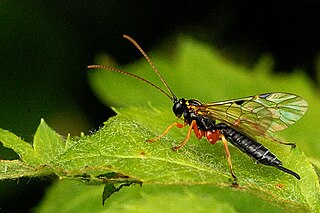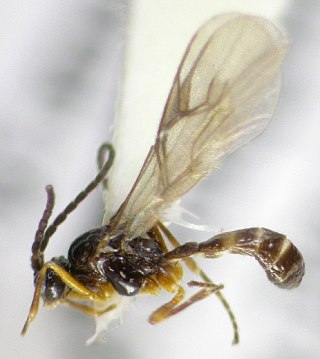
Chalcid wasps are insects within the superfamily Chalcidoidea, part of the order Hymenoptera. The superfamily contains some 22,500 known species, and an estimated total diversity of more than 500,000 species, meaning the vast majority have yet to be discovered and described. The name "chalcid" is often confused with the name "chalcidid", though the latter refers strictly to one constituent family, the Chalcididae, rather than the superfamily as a whole; accordingly, most recent publications (e.g.,) use the name "chalcidoid" when referring to members of the superfamily.

The Ichneumonidae, also known as ichneumon wasps, ichneumonid wasps, ichneumonids, or Darwin wasps, are a family of parasitoid wasps of the insect order Hymenoptera. They are one of the most diverse groups within the Hymenoptera with roughly 25,000 species described as of 2016. However, this likely represents less than a quarter of their true richness as reliable estimates are lacking, along with much of the most basic knowledge about their ecology, distribution, and evolution. It is estimated that there are more species in this family than there are species of birds and mammals combined. Ichneumonid wasps, with very few exceptions, attack the immature stages of holometabolous insects and spiders, eventually killing their hosts. They thus fulfill an important role as regulators of insect populations, both in natural and semi-natural systems, making them promising agents for biological control.

The Braconidae are a family of parasitoid wasps. After the closely related Ichneumonidae, braconids make up the second-largest family in the order Hymenoptera, with about 17,000 recognized species and many thousands more undescribed. One analysis estimated a total between 30,000 and 50,000, and another provided a narrower estimate between 42,000 and 43,000 species.

Glyptapanteles is a genus of endoparasitoid wasps found in all continents, except Antarctica. The larvae of Glyptapanteles species are able to manipulate their hosts into serving as bodyguards.

Pimplinae are a worldwide subfamily of the parasitic wasp family Ichneumonidae.

Microgastrinae is a subfamily of braconid wasps, encompassing almost 3,000 described species, with an estimated 30,000–50,000 total species. This makes it one of the richest subfamilies with the most species of parasitoid wasps.

Agathidinae is a subfamily of braconid parasitoid wasps. Some species have been used in biological control programs.

Anteon is the largest genus in the subfamily Anteoninae of the family Dryinidae, it occurs globally and there is a current total of 464 species described. The species in the genus Anteon are parasitoids of leafhoppers from the family Cicadellidae. The female wasps of the family Dryinidae almost always possess a chelate protarsus, as do females of species within Anteon. The chelae are used to capture and immobilise the host leafhopper to allow the wasp to oviposit and feed on it.

An Essay on the Classification of the Parasitic Hymenoptera of Britain Which Correspond with the Ichneumones Minuti of Linnaeus is a Victorian monograph of entomology published in the Entomological Magazine between 1833 and 1838, by the Irish entomologist Alexander Henry Haliday.

The Euphorinae are a large subfamily of Braconidae parasitoid wasps. Some species have been used for biological pest control. They are sister group to the Meteorinae.
Distatrix is a genus of parasitoid wasps in the family Braconidae. There are more than 30 described species in Distatrix, found throughout most of the world.

Chorebus is a genus of parasitoid wasps in the family Braconidae. There are around 430 accepted species in the genus.

Asobara is a genus of parasitoid wasps in the family Braconidae. It contains around forty species. The genus is best known for the Drosophila parasitoid Asobara tabida, which is notable as both a model for parasitoid wasp infection in insects, and also as a representative of the hologenome theory of evolution. Asobara tabida is commensally infected with Wolbachia, and cannot reproduce in the absence of Wolbachia infection. As such, the genome of Asobara is directly tied to the genome of its commensal Wolbachia symbiont, and the two are considered to have a hologenome.

Phytomyza ranunculi is a species of fly in the family Agromyzidae. It is found in the Palearctic.
Diachasmimorpha is a genus of the Opiinae subfamily of braconid parasitoid wasps and was first described in 1913. It is a small genus relatively restricted to the subtropics but also includes species in the Nearctic and northern Neotropical Regions. The genus is most clearly defined by an apical sinuate ovipositor, which is a synapomorphic character and defines a monophyletic lineage.

Protapanteles is a genus of braconid wasps in the family Braconidae. There are more than 20 described species in Protapanteles, found mainly in the Holarctic.

Aphidius is a genus of insects of the family Braconidae.

Netelia producta is a species of ichneumonid wasp in the subfamily Tryphoninae found in Australia.
Hormius is a genus of parasitoid wasp in the subfamily Hormiinae first described by Christian Gottfried Daniel Nees von Esenbeck in 1818.
















